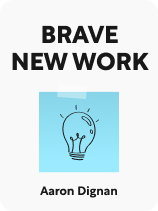

This article is an excerpt from the Shortform book guide to "Brave New Work" by Aaron Dignan. Shortform has the world's best summaries and analyses of books you should be reading.
Like this article? Sign up for a free trial here.
What is the purpose of organizational transformation? How can you reboot a failing business?
Organizational transformation is essential for businesses in the modern day. According to Aaron Dignan’s book Brave New Work, businesses need to be open to change so they don’t fall behind in modern times.
Read below for a closer look at how to prepare your company for organizational transformation.
Set the Stage for Change
To implement the key principles of autonomy and flexibility in your organization, Dignan explains the process of preparing for organizational transformation. He describes guidelines for introducing the principles over the long term and emphasizes the importance of establishing psychological safety and a consent process.
While some leaders might be less inclined to invest time and energy in invisible structures such as these, this type of groundwork is foundational to changes in other areas such as budgets, profit, and productivity.
Introducing the Principles Into Your Organization
Dignan notes the following points to keep in mind at all stages of change, particularly at the beginning when leaders have to commit to the process:
There’s no one-size-fits-all plan. Unlike other organizational strategies that provide step-by-step, detailed instructions, Dignan’s principles require group reflection and collaboration to design a system that works for your specific organization.
(Shortform note: Although each organization will have a unique pathway to becoming more flexible and autonomous, William and Susan Bridges’s Managing Transitions explains that transitions consist of three overall phases: Closing, when people have to move on from the old way of doing things; The Bridge, when an organization is in between the old and new systems; and Emerging, when the changes are implemented and there’s widespread buy-in from team members. In addition, because change and reform are ongoing, leaders have to manage the three phases of transitions all happening concurrently and constantly.)
Maintaining autonomy and flexibility is an ongoing effort. There shouldn’t be just one big overhaul implemented at one point in time, but a long-term commitment to growth and evolution. In addition, the qualities of autonomy and flexibility should guide change at all levels and among all groups within the organization. In other words, you shouldn’t have autonomy and flexibility in one department but not in another.
(Shortform note: Reed Hastings and Erin Meyer’s No Rules Rules discusses Netflix’s strategy for maintaining autonomy and flexibility. The authors identify four key conditions that enable these qualities: a high concentration of talent, an emphasis on innovation over error prevention, a loose company structure, and companywide alignment. Their main deviation from Dignan’s strategies is their recommendation for a high concentration of talent. The authors claim that Netflix can trust its employees with a high level of autonomy because they are the best in the business (not the other way around, as Dignan might suggest).)
Establish Psychological Safety
As a first step for implementing autonomy and flexibility through organizational reforms, Dignan claims that it’s crucial to make sure people feel comfortable being vulnerable and speaking up when they notice something going well or failing. Dignan’s vision for organizations depends on workers deciding for themselves how they can improve the organization. People won’t participate if they fear retaliation or feel that the leadership is not committed to the fundamental principles of autonomy and flexibility.
(Shortform note: In Reinventing Organizations, Laloux goes beyond the need for psychological safety with respect to organizational reforms and discusses the importance of fostering authenticity in individuals more generally within an organization. This means that employees can always feel safe to be themselves (quirks and all), feel respected, and not have to put on a facade of “professionalism.”)
Leaders can foster psychological safety by allowing time for changes to unfold, allowing everyone time to speak in group settings, participating actively in the new changes being implemented, and reassuring group members that there’s room for both failure and growth.
Benefits of Establishing Trust in the Workplace
For leaders, establishing psychological safety boils down to the idea of building trust in the workplace. In Carrots and Sticks Don’t Work, Paul Marciano emphasizes the importance of this concept and explains three key benefits of leaders trusting their employees:
- Employees feel more ownership over their work and are more likely to produce better results so they don’t let their colleagues down.
- Employees feel more comfortable proposing riskier ideas, potentially leading to more innovation.
- Employees are more receptive to change and feedback because they believe their colleagues have their best interests in mind.
Though trust may take a long time to develop, it’s an important foundation for a positive and productive work environment, and the processes proposed by Dignan throughout Brave New Work can all be opportunities for building trust among colleagues.
Establish a Consent Process
In addition to psychological safety, establishing a consent process is another important early step for integrating autonomy and flexibility into an organization. The consent process is meant to enable workers to shape structural change from within, rather than to create an additional hurdle for people to get things done.
To facilitate a democratic process, Dignan recommends using a consent process such as Sociocracy or Integrative Decision Making (IDM).
In the IDM process, each participant has the opportunity to speak and give input on a proposal. Toward the end of the process, participants can either consent to the proposal or raise an objection if they think the proposal is either unsafe to try or would cause irreversible harm. Any objectors then work with the proposer to edit the proposal to get consent to move forward. In a system such as this, the decision-making process is inclusive, but it’s also designed to make progress rather than having ideas thrown out if there’s no consensus.

———End of Preview———
Like what you just read? Read the rest of the world's best book summary and analysis of Aaron Dignan's "Brave New Work" at Shortform.
Here's what you'll find in our full Brave New Work summary:
- How organizations can adapt to the rapid pace of change in the modern world
- Why old organizational structures don't work anymore
- How to enable organizations to run themselves through decentralized work






